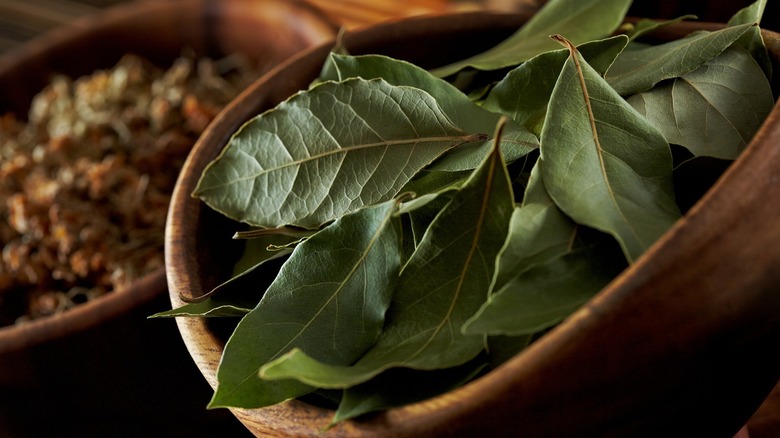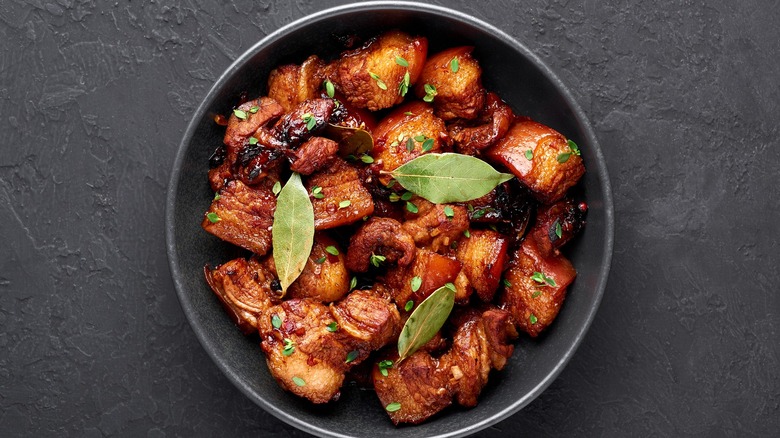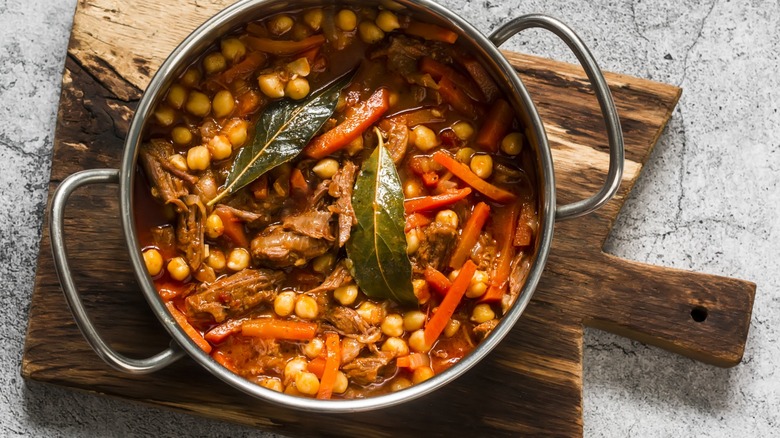What Flavor Do Bay Leaves Actually Add To Your Dishes?
Some people believe that bay leaf adds nothing to a dish. It's such a prevalent notion, in fact, that professionals like Ina Garten admit to not noticing much of a difference when it is an ingredient versus when it is not.
But this simply isn't true. Bay leaves contain a ton of subtle aromatics and flavor. In fact, according to Cook's Illustrated, this misunderstood herb possesses over 50 distinct elements that can be coaxed out, even if that can take up to an hour while cooking. So, what exactly does bay leaf taste like?
There are two main categories: Californian and Turkish (or Mediterranean) bay leaf. While they both have mint and tea undertones, they wield different nuances, the main distinguishing factor being that the former tends to be more intense.
Dig deeper and you'll find those inclined to say that both categories bring flowery notes and tastes like pepper, clove, and sweeter components like apple to a given dish. But people's palettes are subjective, so it gets a little more complicated.
The details of bay leaf's flavor and external factors
Pastry Chef Rose Wilde illustrated how convoluted bay leaf's flavor profile can be when talking to the Washington Post earlier this year. "It tastes so much like you're outside in the forest," Wilde explained. "If one herb had a lot of terroir, I would say it would be bay leaf."
The Los Angeles-based chef and cookbook writer also mentioned elements of pine, cinnamon, and even vanilla. So, aside from the pronounced flavors of mint and eucalyptus, there may be some other elusive tastes that some may not be picking up.
To make this frustrating matter worse, external factors like storage also play a part. As Chef Isaac Toups told Southern Living recently, because bay leaves are sold as a dry product, they have a finite amount of time regarding potency. Since bay leaf loses its strength within a few months, Toups attributes expiration as the reason why people believe the herb has no taste. He added that properly stored leaves have an "earthy sassafras" taste.
Because Californian and Turkish bay leaves come from two independent breeds of the same shrub, they have varying flavor levels. This throws another wrench into the works. After all, California bay leaf typically has an overpowering presence of mint, specifically when fresh. So, if this is what is in a given dish, that might be the only noticeable taste off the bay leaf. The Turkish variety is much more commonly used, however, so it likely won't be a problem for most.
How to get the most from your bay leaves
Bay leaf needs some time to incorporate its essence into a dish. So, the best way to get the most out of bay leaves is by including them in more prolonged preparations. As a result, this means stews, soups, roasts, and any meal that may require at least an hour of cooking.
There's a trick that may help this process along — add them to a meal right at the beginning. As you begin cooking, toss a few leaves in with the oil; it will release some of their flavors more efficiently. This is because the tasty elements within herbs like bay leaves, rosemary, thyme, and sage are more dissolvable in fat rather than water.
On top of that, it's important to remember the herb's dried aspect. Because the leaves are bought in a rigid, dehydrated state, the ingredient makes a great accompaniment when grilling or smoking. Throwing a few leaves on top of the coals or wood when barbecuing should impart some of those delicate flavors as they burn. Either way, bay leaves do taste like something. It's just important to be patient and let them do their thing.


